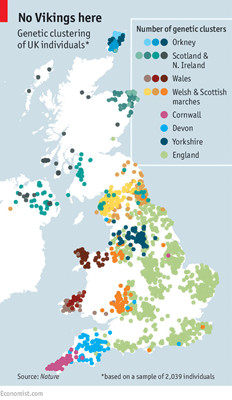The genetic history of Britain
英國的基因史
Who do you think you are?
你認為自己是誰?
An analysis of Britons' genes confirms some myths and explodes others
對英國人基因的一項分析論證了神話中的虛與實
THE waves of invasion and immigration that have, from time to time, swept over the British Isleshave led some to refer to Britons as a mongrel nation. A study just published in Nature by Peter Donnelly of Oxford University and his colleagues shows there is some truth in this, and that the palimpsest of those events is visible in people's genes—or, at least, that it was still discernible in the late 19th century.
外部入侵與移民浪潮時常席卷不列顛群島,因此,有人將英國稱為混血國。牛津大學教授彼得·多納利與其同事在《自然》雜志上剛發表了一項研究,該研究表明:混血國的說法有一定的真實性,并且這些風云變幻的歷史在人們的基因中有所體現(或者,至少在19世紀晚期依然可辨)。

Dr Donnelly's team looked in detail at the DNA of 2,039 Britons from all parts of Great Britain and Northern Ireland, each of whose grandparents had all been born within 80km of each other. They thus, in effect, sampled the distribution of genetic material in the country in 1885 (the average year of the birth of these grandparents), before the large-scale internal population movements of the 20th century had had a chance to confuse the issue. The results divided into 17 genetic clusters, illustrated on the map, which form a pattern that conforms quite well with what an historian might have predicted, but with some interesting wrinkles.
多納利博士的研究團隊對來自大不列顛島和北愛爾蘭島各個地域的2039名英國人基因進行了詳細研究,研究對象的祖父母均出生在距離對方80公里以內的地方。20世紀國內人口出現大規模流動,因此,該團隊實際抽取了英國1885年(研究對象祖父母平均出生的年份)的基因材料作為樣本分析,以防止出現失真的情況。研究結果分為17個基因群,其分布情況與一位歷史學家的預測完全一致,但同時存在一些有趣的難題。
The map is dominated by a DNA cluster that might reasonably be described as “English”. Comparison with continental Europe shows, as might be expected, that this English cluster is related to northern Germany, where the Anglo-Saxons came from—though the admixture is less than 50%, which indicates (again, as expected) that there was much interbreeding between interlopers and natives.
可合理稱之為“英格蘭人”的基因群在地圖上的分布數量最多。對照歐洲大陸后發現,正如所料,此基因群與安格魯-撒克遜人的來源地德國北部相關聯。混血基因范圍不到一半,但這(再次如其所料)表明入侵者與本土人之間出現大量通婚現象。
Others kept themselves to themselves. Yorkshiremen and women will be gratified to note that the west of their county clusters separately from the rest of England, and Lancastrians similarly horrified that Yorkshire's tendrils extend into much of theirs.Cornwall, too, clusters separately from England. Indeed, as all good Cornish would have suspected, it clusters separately even from Devon (which is itself also genetically different fromEngland).
而其他地域只是內部通婚。約克郡男女得知英國西部的基因群不同于英格蘭其他地區后會滿心歡喜,而蘭開夏郡人則為約克郡人的觸手深入自己的地盤感到萬分驚駭。康沃爾(英格蘭西南部)的基因群也不同于英格蘭。的確如此,該郡的基因群甚至不同于德文郡(其基因亦與英格蘭不同),這一點一直為善良的康爾沃人所懷疑。
The whole so-called Celtic fringe, of areas in the west and north of Great Britain that were not invaded by the Saxons, is far more genetically diverse than its mythopoeic appellation suggests. Orkney, which has three clusters of its own, looks Norse. That is no surprise. It was, after all, part of Norwayfor 600 years. But north and south Wales are different from each other, and mainland Scotland has several clusters (two of which—a consequence, presumably, of the 17th-century plantations organised by King James VI and I—extend into Northern Ireland). The marcher lands between Englandand Scotland, and between England andWales, harbour still further indigenous clusters.
所謂的凱爾特郡邊緣地帶整體包括薩克遜人未曾侵入的大不列顛西部和北部地區,其基因多樣性遠多于其神話時代名稱所指的數量。自身分布有三個基因群的奧克尼郡極像挪威。這不足以為奇。它畢竟在挪威的統治下600年。但威爾士南北部互不相同,同時,蘇格蘭本土分布著幾個基因群(其中兩個據推測為17世紀詹姆斯國王一世和六世組織種植園的結果,并蔓延至北愛爾蘭)。英格蘭分別與蘇格蘭、威爾士的接界處還分布有土著基因群。
The original Celts occupied a huge swathe of western Europe before the Roman conquest, so perhaps this diversity is not so surprising after all. Indeed, Dr Donnelly's analysis found traces of genetic connections throughout the land with modern Belgium(which is named after a Celtic tribe, the Belgae) and various parts of France—or Gaul, as the Romans knew it. He did not, though, find any traces of the Vikings beyond those in Orkney, even though they held sway for some time over the eastern part of England. Maybe their fearsome reputation for uninvited sexual congress with local maidens was yet another myth.
土著凱爾特人在羅馬人征服英國之前占有歐洲西部的大片區域,因此,基因存在多樣性也許是情理之中的事情。確實,多納利博士經此次分析認為,有跡象表明該地區與現今比利時(該名取自凱爾特地區的貝爾格族)以及法國多個地區—羅馬人所熟知的高盧—存在基因關聯。然而,盡管維京人在一段時間內統治英格蘭東部地區,但除奧克尼以外,他沒有發現維京人的其他任何跡象。或許,他們與當地少女私下交配這一可怕的名聲還是另一個謎。翻譯:石海霞 校對:胡雅琳












